
Bing Crosby
lounge music
Support www.hipchristmas.com! ![]() Shop at
Amazon,
Apple Music, and more...
Shop at
Amazon,
Apple Music, and more...
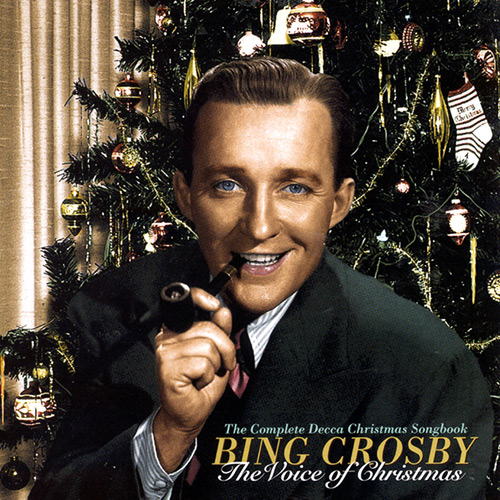 My
credo at Hip Christmas is to trumpet the
merits of Christmas music that "rocks, rolls, swings, or twangs." In that
light, writing about Bing
Crosby becomes problematic, because Der Bingle did none of those things. Unlike
many of Crosby's crooning peers - Frank Sinatra, Dean Martin, Nat "King" Cole,
Johnny Mathis - Bing remained resolutely square throughout his career. Regardless
of how many records he sold - and he sold a lot - Crosby's music began and ended
as something your grandmother would (and probably did) like. Was he popular? Yes.
Talented? Surely. Hip? Not even close.
My
credo at Hip Christmas is to trumpet the
merits of Christmas music that "rocks, rolls, swings, or twangs." In that
light, writing about Bing
Crosby becomes problematic, because Der Bingle did none of those things. Unlike
many of Crosby's crooning peers - Frank Sinatra, Dean Martin, Nat "King" Cole,
Johnny Mathis - Bing remained resolutely square throughout his career. Regardless
of how many records he sold - and he sold a lot - Crosby's music began and ended
as something your grandmother would (and probably did) like. Was he popular? Yes.
Talented? Surely. Hip? Not even close.
Nevertheless, it is impossible to discuss modern Christmas music without careful consideration of Bing Crosby's enormous holiday oeuvre. Why? Well, it all boils down to "White Christmas," a song written by Irving Berlin and first recorded by Crosby for Holiday Inn, his 1942 film with Fred Astaire. An Oscar winner that year for best song, "White Christmas" was also a humongous smash (#1 on the pop and R&B charts) and continued to chart nearly every year for the next three decades, selling untold millions of copies. Crosby recorded "White Christmas" again in 1947, this time in a polished arrangement that became the definitive rendition of the most pervasive song ever. More famously, Crosby waxed yet another version in 1954 for White Christmas, a new film (starring Crosby, Danny Kaye, Rosemary Clooney, and Vera Allen) that transformed its title song from a mere smash hit into a modern manifesto.
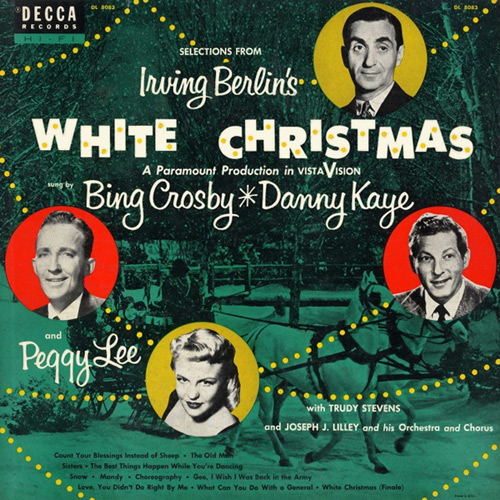 What
exactly made "White Christmas" - a simple song written by a Jew - so
captivating and so revolutionary? The fact that it sold so many copies can't be,
well, undersold. Popularity has a way of begetting itself. More profoundly, the
song was instrumental in transforming Christmas from a religious holiday into a
secular one. Irving Berlin's Christmas was pure and white, indeed - cleansed of
any mention of God, with nary a trace of Jesus and barely a hint of Santa Claus,
yet full of warm, fuzzy, familial feelings. It was a holiday made safe for humanism
- and that, folks, is modern!
What
exactly made "White Christmas" - a simple song written by a Jew - so
captivating and so revolutionary? The fact that it sold so many copies can't be,
well, undersold. Popularity has a way of begetting itself. More profoundly, the
song was instrumental in transforming Christmas from a religious holiday into a
secular one. Irving Berlin's Christmas was pure and white, indeed - cleansed of
any mention of God, with nary a trace of Jesus and barely a hint of Santa Claus,
yet full of warm, fuzzy, familial feelings. It was a holiday made safe for humanism
- and that, folks, is modern!
Consider, then, another Crosby-sung, Oscar-nominated song on the White Christmas soundtrack, "Count Your Blessings Instead Of Sheep." The song contains neither explicitly religious or obviously seasonal imagery, yet most listeners assume it is a deeply religious, seasonal song. This effect is a testament both to the power of Irving Berlin's songcraft and the force of Bing Crosby's personality. Arguably, however, this meager song represents the birth of modern marketing - the triumph of context over content, the commingling of sacred and profane, the substitution of meaningless for meaningful. Perceptual sleight of hand or the death of organized religion? Tough call.
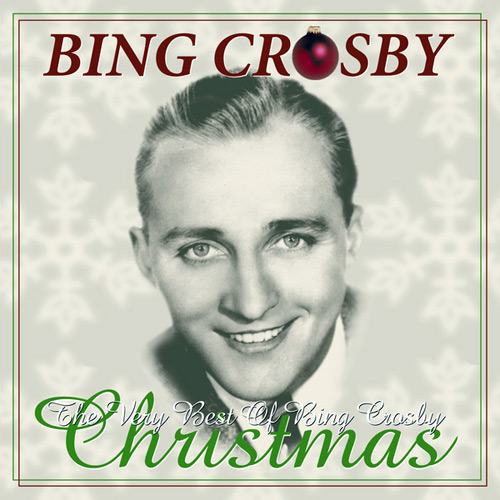 Bing
Crosby, it should be noted, was a pious man - so much so that he balked at the
idea of a pop singer such as himself even recording Christmas songs. Not surprisingly,
then, his first Christmas sessions in 1935 for Decca Records produced songs full
of piety, but little else. Both of these songs ("Silent Night" and "Adeste
Fideles") charted, but it was Holiday
Inn - which produced "Happy Holiday" and "Let's Start The New
Year Right" in addition to "White Christmas" - that started Crosby
down his singular road. Bing's 20 years at Decca produced roughly 40 official Christmas
masters that introduced a number of important new songs including "I'll Be
Home For Christmas," "A Marshmallow World," "You're All I Want
For Christmas," and "It's Beginning To Look A Lot Like Christmas."
Bing
Crosby, it should be noted, was a pious man - so much so that he balked at the
idea of a pop singer such as himself even recording Christmas songs. Not surprisingly,
then, his first Christmas sessions in 1935 for Decca Records produced songs full
of piety, but little else. Both of these songs ("Silent Night" and "Adeste
Fideles") charted, but it was Holiday
Inn - which produced "Happy Holiday" and "Let's Start The New
Year Right" in addition to "White Christmas" - that started Crosby
down his singular road. Bing's 20 years at Decca produced roughly 40 official Christmas
masters that introduced a number of important new songs including "I'll Be
Home For Christmas," "A Marshmallow World," "You're All I Want
For Christmas," and "It's Beginning To Look A Lot Like Christmas."
All those recordings, however, produced just one full-length album, Merry Christmas (1955). Remember, Crosby recorded many of his Decca sides before the advent of the 12-inch LP, so most of his "albums" were 45- or 78-rpm boxed sets or EP's. The Merry Christmas LP, in fact, descended from just such an album - originally issued in 1942 and subsequently retooled several times through the years before finally being retitled White Christmas in 1986. The various incarnations of this LP add up to one of the most popular albums - Christmas or otherwise - in the history of the known galaxy. But, at just 12 songs long, White Christmas barely scratches the surface of Der Bingle's hefty Decca legacy.
[close]
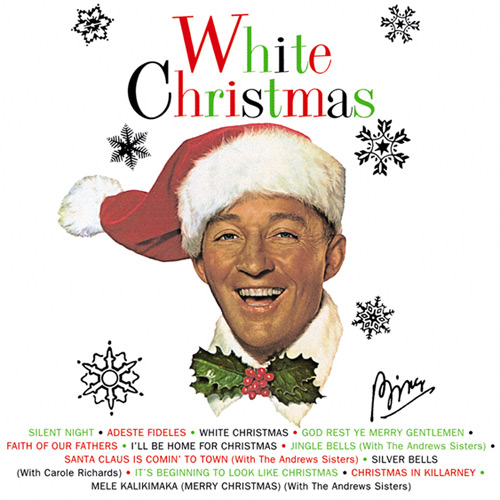 Thankfully,
Universal Music (which now owns the Decca masters) upgraded Crosby's catalog
with a series of lovely CD's. First and foremost is The
Voice Of Christmas (1998), a 2-disc set that incorporates everything save a
handful of non-Christmas cuts (e.g. "Count Your Blessings" or "Faith
Of Our Fathers") from his Christmas-related records. The following year, Universal
issued a single-disc version of the same (Very
Best Of Bing Crosby Christmas) that, while acceptable, places too much emphasis
on predictable carols ("The First Noël") at the expense of more esoteric
originals ("Poppa Santa Claus"). In 2003, the label repackaged that disc
as 20th
Century Masters: The Christmas Collection.
Thankfully,
Universal Music (which now owns the Decca masters) upgraded Crosby's catalog
with a series of lovely CD's. First and foremost is The
Voice Of Christmas (1998), a 2-disc set that incorporates everything save a
handful of non-Christmas cuts (e.g. "Count Your Blessings" or "Faith
Of Our Fathers") from his Christmas-related records. The following year, Universal
issued a single-disc version of the same (Very
Best Of Bing Crosby Christmas) that, while acceptable, places too much emphasis
on predictable carols ("The First Noël") at the expense of more esoteric
originals ("Poppa Santa Claus"). In 2003, the label repackaged that disc
as 20th
Century Masters: The Christmas Collection.
Throughout his career, Crosby frequently collaborated with other artists, including Peggy Lee ("Little Jack Frost Get Lost," 1952) and Carol Richards ("Silver Bells," 1950). His partnership with the Andrews Sisters was the most significant, resulting in six of the best holiday tracks either artist ever committed to posterity - especially "Mele Kalikimaka," a kitschy, counterfeit Hawaiian carol. True, Crosby's Voice Of Christmas has all six sides, but so does A Merry Christmas With Bing Crosby & The Andrews Sisters (2000) - along with a smart selection of solo sides from both Bing and the winsome trio. Excellent one-stop shopping, but probably not sufficient for serious fans of vintage Christmas music.
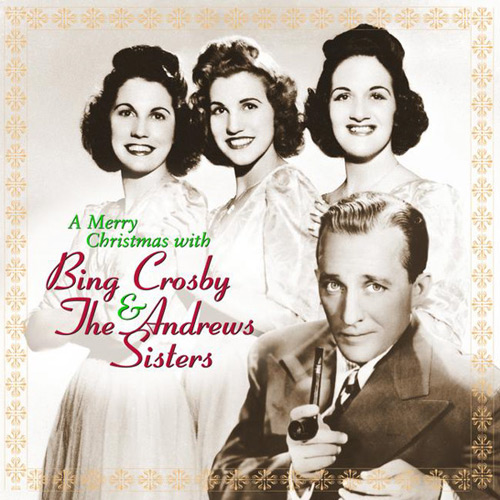 After
parting ways with Decca - his label for nearly 20 years - Crosby entered the long,
final phase of his career wherein he quite literally became an American institution
- representing Christmas, God, and country in the eyes of many. In the late 50's
and early 60's, however, he continued to produce new Christmas records at a rapid
pace. In 1957, he waxed "How Lovely Is Christmas" (with Arthur Norman's
orchestra and choir) for Kapp Records. The same year, he recorded a children's record also called How Lovely Is Christmas for Golden Records backed by Mitch Miller. The album has been
reissued on compact disc several times by several labels under several titles -
including A
Christmas Story: A Holiday Musical Told and Sung by Bing Crosby (2001).
After
parting ways with Decca - his label for nearly 20 years - Crosby entered the long,
final phase of his career wherein he quite literally became an American institution
- representing Christmas, God, and country in the eyes of many. In the late 50's
and early 60's, however, he continued to produce new Christmas records at a rapid
pace. In 1957, he waxed "How Lovely Is Christmas" (with Arthur Norman's
orchestra and choir) for Kapp Records. The same year, he recorded a children's record also called How Lovely Is Christmas for Golden Records backed by Mitch Miller. The album has been
reissued on compact disc several times by several labels under several titles -
including A
Christmas Story: A Holiday Musical Told and Sung by Bing Crosby (2001).
Then, in 1962, Bing Crosby produced a brand new LP for Warner Brothers entitled I Wish You A Merry Christmas, mixing fairly dull traditional carols with jaunty, brassy arrangements of modern songs like "Winter Wonderland," "Let It Snow," and "Frosty The Snowman." Tellingly, Crosby chose not to revisit his greatest hit, "White Christmas." He quickly follow the album with a truly significant release for Capitol Records, the debut - and definitive - recording of the now-classic "Do You Hear What I Hear?" Backed with another new song (the clever, unbelievably corny "Christmas Dinner Country Style"), the single was Crosby's last big seasonal hit (#2 on Billboard's Christmas charts), though his amazing run of 42 annual Christmas radio and TV specials would be cancelled only by the Grim Reaper. (By the way, see Varese Sarabande's 2007 compilation A Crosby Christmas for a sampling of those specials.)
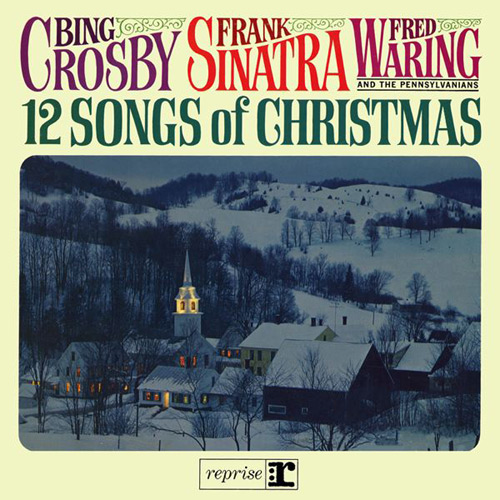 In
1964, Papa Bing lent a hand to buddy Frank Sinatra's nascent record label, Reprise,
collaborating with Ol' Blue Eyes and Fred Waring's Pennsylvanians on a traditional
LP, 12 Songs Of Christmas. He followed that in 1965 with a new single
for Reprise, "The White World Of Winter." For some reason, this portion
of Crosby's Christmas catalog has rarely been anthologized on CD, with a couple
of the Waring tracks showing up on Frank Sinatra discs like Christmas
Collection along with some later TV appearances (read
more) and "White World Of Winter" appearing only on Sony's Winter
Holiday (2001). The Waring recordings do appear, sadly, on chintzy budget albums
with alarming frequency - caveat emptor.
In
1964, Papa Bing lent a hand to buddy Frank Sinatra's nascent record label, Reprise,
collaborating with Ol' Blue Eyes and Fred Waring's Pennsylvanians on a traditional
LP, 12 Songs Of Christmas. He followed that in 1965 with a new single
for Reprise, "The White World Of Winter." For some reason, this portion
of Crosby's Christmas catalog has rarely been anthologized on CD, with a couple
of the Waring tracks showing up on Frank Sinatra discs like Christmas
Collection along with some later TV appearances (read
more) and "White World Of Winter" appearing only on Sony's Winter
Holiday (2001). The Waring recordings do appear, sadly, on chintzy budget albums
with alarming frequency - caveat emptor.
Before his final chapter was written, Bing Crosby recorded one more Christmas album - one that would be largely overlooked at the time and largely forgotten by history. It wasn't for lack of trying, however. A Time To Be Jolly (Daybreak, 1971) featured a decidely more modern sound with support from respected show biz types like bandleader Les Brown, choral director Jack Halloran, and producer Sonny Burke. The album consisted of mostly new compositions, and it employed the novel concept of having Halloran's singers introduce the tracks with brief bits of songs by Alfred Burt, the composer of "Some Children See Him" and other modern Christmas carols. Regardless, the album sank like a stone, and it proved to be Crosby's final full-length holiday effort.
By the way, A Time To Be Jolly was reissued in Europe as A Christmas Toast (20th Century, 1973), and it's been reissued on CD by Polygram both as A Christmas Toast (1993) and Christmas Album (1994).
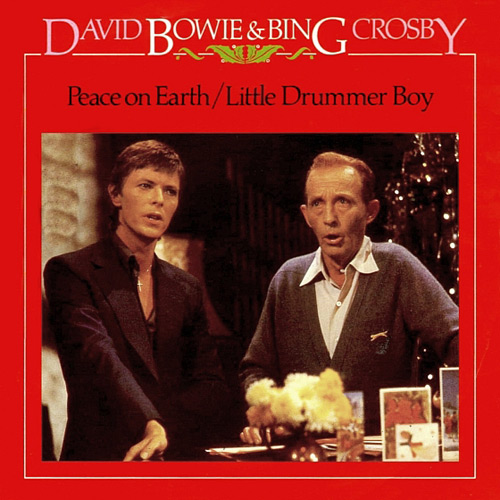 It would take a team of researchers many years
to unravel all the Christmas sides Bing Crosby recorded - not to mention the hundreds of
albums issued by dozens of labels on LP, tape, and CD. But, I can say with confidence that Bing generated very little new holiday music during the last few years of his life.
Just before his death, though, Crosby managed one last session that would cement
his legacy as the King of Christmas for a younger generation who thought of him
as little more than an old fogey who sold orange juice. Crosby historian Steven
Lewis describes the event:
It would take a team of researchers many years
to unravel all the Christmas sides Bing Crosby recorded - not to mention the hundreds of
albums issued by dozens of labels on LP, tape, and CD. But, I can say with confidence that Bing generated very little new holiday music during the last few years of his life.
Just before his death, though, Crosby managed one last session that would cement
his legacy as the King of Christmas for a younger generation who thought of him
as little more than an old fogey who sold orange juice. Crosby historian Steven
Lewis describes the event:
One of the more surreal moments in pop music history took place September 11, 1977, when the leading American pop star of the first half of the 20th century met and performed with one of the most innovative rockers of the last half. Crosby was in London to conduct a concert tour and tape his annual Christmas TV special. It was Bing's idea that he should have as a guest on his TV show a young star. Someone suggested David Bowie. Bing had never heard of Bowie, but his kids had, so an invitation was sent to the rock star. Bowie, as it turned out, was a secret fan of Der Bingle and jumped at the chance to perform with him.
Bing's idea was that he and Bowie would perform "The Little Drummer Boy" as a duet. Bowie felt the song did not showcase his voice very well, so the writers added "Peace on Earth," which suited Bowie's voice quite well. Two musical spokesmen of different generations met for the first time on the morning of the taping, rehearsed for just an hour, and finished their duet in only three takes. Bing was impressed with Bowie and gave him his phone number at the end of the taping. Bing told an interviewer four days later that he considered Bowie "a clean cut kid and a real fine asset to the show. He sings well, has a great voice, and reads lines well. He could be a good actor if he wanted."
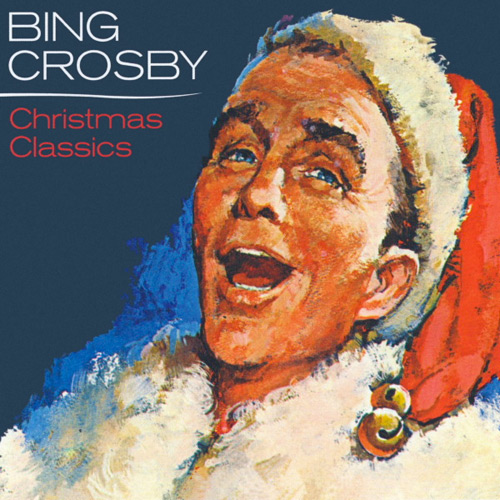 Bing
died just a month later, dropping dead of heart failure on October 14 while playing
a round of golf. Dave and Bing's performance aired, then, after Crosby's death,
forming a memorable tribute to his broad appeal. In fact, TV Guide chose the duet
as one of the 25 best musical moments in television history. "Peace On Earth/Little
Drummer Boy" was not released commercially, however, until 1982 when David
Bowie's former label RCA issued it on 45 backed with Bowie's "Fantastic Voyage" (later
issued on CD
single by Oglio Records).
Bing
died just a month later, dropping dead of heart failure on October 14 while playing
a round of golf. Dave and Bing's performance aired, then, after Crosby's death,
forming a memorable tribute to his broad appeal. In fact, TV Guide chose the duet
as one of the 25 best musical moments in television history. "Peace On Earth/Little
Drummer Boy" was not released commercially, however, until 1982 when David
Bowie's former label RCA issued it on 45 backed with Bowie's "Fantastic Voyage" (later
issued on CD
single by Oglio Records).
After the fact, Capitol Records gained rights to Bing's 1962 LP for Reprise, and in 1977 they compiled it all along with both sides of their own 1963 single on a new LP, Bing Crosby's Christmas Classics. By 1998, they also had access to the Bowie duet through their Virgin subsidiary, and they added it to the CD reissue (with new cover) to form a near-perfect companion to MCA's Voice Of Christmas; a 2006 repackage restored the original artwork and added more tracks. Last time I checked, nearly 200 CD's on Amazon answered to a query of "Bing Crosby Christmas," but just two of those albums (comprising three CD's) will provide you with roughly 75% of Der Bingle's massive holiday offerings - and an even higher percentage of his most essential songs. Toss in The Crosby Christmas Sessions (Collector's Choice, 2010), which culls an assortment of post-Decca rarities, and you are more than covered.
Much later, Universal issued Ultimate Christmas (2024), a 28-song compilation on CD and double-LP. At first glance, it would appear to just be an updated version of The Voice Of Christmas, though it was offered in a variety of cool colored vinyl options. But, it was also issued as a 58-track digital deluxe edition, so there's a lot more to explore.
But, should you care that much? Probably not. A few hits and some sentimental favorites will likely suffice for most listeners. From my perspective, however, Bing Crosby is a towering figure - not for his music, per se, but for how he primed the pump for the rock and rhythm & blues Christmas records I treasure so much. Simply, without Bing Crosby, Christmas records in the popular idiom might have never caught on. Listen for instance, to the Drifter's monumental rendition of "White Christmas," a quantum leap forward for doo wop and one of the greatest Christmas records ever made. Based on an arrangement by the Ravens, the Drifters' song is most important for introducing Clyde McPhatter to a pop audience, and the record literally helped kick-start rock & roll. But, before McPhatter's thrilling tenor trills, before the group's death-defying coda, bass singer Bill Pinkney performs a spot-on impersonation of... Bing Crosby. And that, folks, is hip! [top of page]
 Albums
Albums
- - original albums -
- Holiday Inn (soundtrack, 1942)
- Merry Christmas (1945, 1949, and 1955)
- Christmas Greetings (with the Andrews Sisters, 1949)
- White Christmas (soundtrack, 1954)
- How Lovely Is Christmas (1957)
- I Wish You A Merry Christmas (1962)
- 12 Songs Of Christmas (with Frank Sinatra and Fred Waring's Pennsylvanians, 1964)
- A Time To Be Jolly (1971)
- - reissues and compilations -
- Bing Crosby's Christmas Classics (1977)
- White Christmas (1986)
- Christmas Album (1994)
- The Voice Of Christmas (1998)
- Very Best Of Bing Crosby Christmas (1999)
- A Merry Christmas With Bing Crosby & The Andrews Sisters (2000)
- A Christmas Story: A Holiday Musical Told and Sung by Bing Crosby (2001)
- 20th Century Masters: The Christmas Collection (2003)
- Bing Crosby's Christmas Classics (repackaged, 2006)
- A Crosby Christmas (radio broadcasts, 2007)
- How Lovely Is Christmas (2007)
- The Crosby Christmas Sessions (2010)
- 10 Great Christmas Songs (2012)
- Christmas With Bing! (2013)
- Icon: Christmas (2014)
- Bing At Christmas (with the London Symphony Orchestra, 2019)
- Christmas Gems (2023)
- Ultimate Christmas (2024)
- Ultimate Christmas: Digital Deluxe Edition (2024)
 Essential Songs
Essential Songs
- Christmas Dinner Country Style (1963)
- Christmas In Killarney (1951)
- Count Your Blessings Instead Of Sheep (1954)
- Do You Hear What I Hear? (1963)
- The First Snowfall (1955)
- Frosty The Snowman (1962)
- Happy Holiday (1942)
- Here Comes Santa Claus (with the Andrews Sisters, 1949)
- How Lovely Is Christmas (1957)
- I'll Be Home For Christmas (1943)
- Is Christmas Only A Tree? (1955)
- It's Beginning To Look A Lot Like Christmas (1951)
- Jingle Bells (with the Andrews Sisters, 1943)
- Let It Snow, Let It Snow, Let It Snow (1962)
- Let's Start The New Year Right (1942)
- Little Jack Frost, Get Lost (with Peggy Lee, 1952)
- Looks Like A Cold, Cold Winter (1950)
- A Marshmallow World (1951)
- Mele Kalikimaka (with the Andrews Sisters, 1950)
- Peace On Earth/Little Drummer Boy (with David Bowie, 1977)
- Poppa Santa Claus (with the Andrews Sisters, 1950)
- Rudolph The Red-Nosed Reindeer (1950)
- Santa Claus Is Coming To Town (with the Andrews Sisters, 1943)
- Silent Night (1935)
- Silver Bells (with Carol Richards, 1950)
- That Christmas Feeling (1950)
- Twelve Days Of Christmas (with the Andrews Sisters, 1949)
- White Christmas (1947)
- White World Of Winter (1965)
- Winter Wonderland (1962)
- You're All I Want For Christmas (1949)
 Further Listening
Further Listening
- Billboard Greatest Christmas Hits 1935-1954 (various artists, 1989)
- Christmas Kisses: Christmas Classics From Capitol's Early Years (various artists, 1990)
- The Christmas Song (Nat King Cole, 1961)
- The Coolest Christmas (various artists, 1994)
- Croon & Swoon: A Classic Christmas (various artists, 1998)
- Jolly Christmas From Frank Sinatra (1957)
- Making Spirits Bright (Dean Martin, 1998)
- Santamental Journey: Pop Vocal Christmas Classics (various artists, 1995)
- Snowfall (Tony Bennett, 1968)
- The 12 Hits Of Christmas (various artists, 1976)



